Are you tired of staring at those dull drywall garage walls and craving an upgrade?
From eco-friendly hemp panels to sleek corrugated metal, we’ve compiled a list of the top drywall alternatives to consider.
Whether you’re seeking a cozy, rustic vibe with barn boards or aiming for a heavy-duty workspace with cement boards, we’ve got you covered.
This comprehensive guide will rank 12 fantastic drywall alternatives to suit every garage style and budget.
Let’s get started.
How We Ranked Garage Drywall Alternatives
When weighing your options for drywall alternatives, there are a few key factors to consider. We’re going to break it down, specifically looking at how these alternatives would work in your garage.
Durability: Your garage needs to survive a lot of wear and tear, and some materials are more durable than drywall. These can be a great option for working garages or if you plan to hang heavy tools.
Moisture resistance: Garages and basements can be damp places. Consider materials that resist water damage, like cement boards, PVC panels, or fiberglass-reinforced panels (FRP).
Insulation: I’m a big fan of garage insulation, especially if it’s cheap. Some materials are better insulated than others. You want something that keeps the outside air out of your garage.
Looks: The goal of transforming your garage is to make it look good, right? Choose a material that matches your style and decor. For a sleek, modern look, consider corrugated metal or PVC panels. Reclaimed wood or slatwall panels might be right up your alley if you like a more rustic vibe.
Ease of installation: I’ve been through the process of drywalling my garage, and let me tell you, it’s not easy. Alternatives like plywood, slatwall, or PVC panels can be relatively simple to install while still looking great.
Budget: Last but not least, consider your budget. Some drywall alternatives may be more cost-effective than others. Plywood, for example, is usually cheaper than metal panels or high-end slatwall systems. Be sure to strike the right balance between quality and cost for your garage transformation.
The Top 13 Drywall Alternatives for Your Garage [Ranked]
With these factors in mind, let’s rank the best drywall alternatives for your garage walls.
Wahoo Walls
Wahoo Walls are a user-friendly system for finishing basements and interior walls, but they can also be used in your garage. These easy-to-install, textured wall panels come with aluminum tracks, making them simple to put up. They help stop mold from growing and keep your basement warm with built-in insulation.
Here’s how they rank:
- Durability: Wahoo Walls are made from a combination of materials, including a rigid foam core and a mineral board surface, making them relatively durable and suitable for general garage use. Score: 7/10
- Moisture resistance: Wahoo Walls are designed to be moisture-resistant, making them a good choice for damp environments or spaces with moisture concerns. Score: 9/10
- Insulation: Wahoo Walls are known for being great insulators. The rigid foam core provides excellent thermal insulation, which can help maintain a comfortable temperature in your garage. Score: 9/10
- Looks: Wahoo Walls have a clean, finished appearance that can be painted or customized to match your desired style. They offer a versatile look that can work with various garage aesthetics. Score: 8/10
- Ease of installation: Wahoo Walls are designed for easy, DIY installation. The panels are lightweight and can be easily cut to size, making the installation process relatively simple. Score: 9/10
- Budget: Wahoo Walls can be more expensive than some other sheetrock alternatives for garage, but their benefits in terms of insulation, moisture resistance, and ease of installation may justify the higher cost for many homeowners. Score: 7/10
Overall Score: 8.2/10
Wahoo Walls score an impressive 8.2/10 as garage wall coverings. They excel in insulation, moisture resistance, aesthetics, and ease of installation.
Although they can be pricier than some sheetrock alternatives for garages, their many benefits make them a strong contender for a garage makeover, particularly if insulation is your priority.
PVC Panels
PVC panels, like those from Trusscore and other brands, are a much more durable alternative to drywall for your garage and home.
They are made from a tough plastic that resists scratches and dents and lasts a very long time. PVC plastic panels also resist water and moisture, which helps keep mold and mildew away in damp areas.
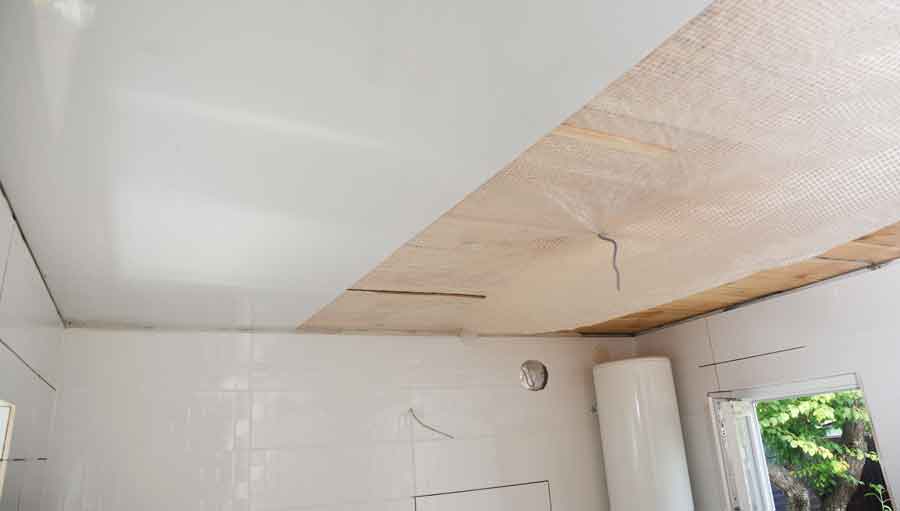
One thing that makes them particularly well-suited for garage applications is that they reflect light, making any room look bigger and brighter.
Here’s how they rank:
- Durability: PVC panels are one of the more durable drywall alternatives. They can handle everyday wear and tear in a garage setting. They may not be as tough as metal or cement board, but they’re still a solid choice for most garage environments. Score: 7/10
- Moisture resistance: PVC panels excel in this category. They’re resistant to water, mold, and mildew, making them an excellent choice for damp garages or spaces with moisture concerns. Score: 10/10
- Insulation: While PVC panels don’t provide significant insulation, they offer some thermal resistance. You may still want to add extra insulation behind them for optimal temperature control. Score: 6/10
- Looks: PVC panels come in various colors and finishes, allowing you to customize them to fit your garage decor. They have a clean, modern look that looks great. Score: 8/10
- Ease of installation: One of the perks of PVC panels is their ease of installation. They’re lightweight, easy to cut, and can be quickly attached to wall studs. This makes them an excellent option for DIY enthusiasts. Score: 9/10
- Budget: PVC panels are generally affordable, making them a budget-friendly choice for garage wall coverings. Their cost-effectiveness, durability, and moisture resistance make them an attractive option. Score: 8/10
Overall Score: 8/10
PVC panels score an impressive 8/10 as garage wall coverings. They perform well in terms of durability, moisture resistance, aesthetics, and ease of installation.
While they’re not the best insulators, their many other benefits make them one of the best drywall alternatives for your garage.
Corrugated Metal Panels
Corrugated metal panels are wall coverings made from ridged or grooved metal sheets.
They’re durable, lightweight, and easy to maintain, adding a unique, industrial look to a space that can be used indoors and outdoors. Often used in commercial or agricultural settings, they are also becoming popular for residential use, particularly in modern or rustic-style homes.

Here’s how they rank:
- Durability: Corrugated metal panels are super durable and can withstand a lot of wear and tear. They also resist impacts, making them perfect for a busy garage environment. Score: 9/10
- Moisture resistance: These panels excel in moisture resistance. They won’t rot or warp and can easily be wiped clean if they get wet. No mold or mildew concerns here! Score: 10/10
- Insulation: Metal panels aren’t the best insulators. I recommend adding some insulation behind them to maintain a comfortable temperature in your garage. Score: 5/10
- Looks: Corrugated metal panels have a unique, industrial look that can be appealing in the right setting. They’re not for everyone, but they can create a stylish and modern vibe for those who like the aesthetic. Score: 8/10
- Ease of installation: Installing corrugated metal panels can be a bit more challenging than some other options, but it’s still doable for DIY enthusiasts. Due to their sharp edges, you’ll need to take extra care when cutting and handling the panels. Score: 6/10
- Budget: While corrugated metal panels may not be the most budget-friendly option, they’re still reasonably priced compared to some high-end alternatives. Remember that you might also need to invest in extra insulation. Score: 7/10
Overall Score: 7.5/10
Corrugated metal panels score a solid 7.5/10 as garage drywall alternatives. They shine (pun intended) in terms of durability, moisture resistance, and aesthetics.
Still, they’re not the best insulators and can be a bit trickier to install. If you’re into the industrial look and willing to put in a little extra effort, they could be an awesome drywall alternative for your garage makeover!
Cement Board
A cement board is a wall covering made from a blend of cement and reinforcing fibers. It is a durable, moisture-resistant material often used in areas prone to water exposure, such as bathrooms and kitchens.

Cement boards provide a sturdy surface for applying tiles or stucco and can be used as stone or brick veneer backing. They are easy to cut and install, making them a popular choice for both residential and commercial applications.
Many homeowners opt to add a conventional or veneer plaster to the cement board to add durability. The plaster walls also look more finished than raw cement board panels.
Here’s how it ranks:
- Durability: Cement board is a highly durable material that can withstand considerable wear and tear. It’s perfect for garages where heavy tools or machinery might be in use. Score: 10/10
- Moisture resistance: Cement board excels in this category because it’s resistant to water, mold, and mildew. It’s an excellent choice for damp garages or basements. Score: 10/10
- Insulation: While cement board doesn’t provide much insulation on its own, it can be paired with insulation materials for temperature control. Score: 6/10
- Looks: Cement board has a utilitarian appearance, which may not be everyone’s cup of tea. You can paint or finish it to make it more visually appealing. However, it may not have the same versatility as other options. Score: 6/10
- Ease of installation: Due to its weight and rigidity, installing cement board can be more challenging than other drywall alternatives. It’s still doable for DIY enthusiasts, but you may need extra help or specialized tools. Score: 6/10
- Budget: Cement board is generally more expensive than options like plywood, MDF, or OSB, but it’s still affordable compared to high-end alternatives. Its durability and moisture resistance may justify the higher cost. Score: 7/10
Overall Score: 7.5/10
Cement board scores a solid 7.5/10 as a garage wall covering. Its strengths are its durability and moisture resistance. However, it’s not the best insulator and can be more challenging to install.
Its appearance may not suit everyone’s taste. Still, cement board is one of the better garage drywall alternatives if you prioritize durability and moisture resistance.
Cork Panels
Cork panels are made from natural cork, a renewable material harvested from the bark of cork oak trees. It’s popular because the trees don’t have to be cut down to harvest their bark.
These panels offer a unique, textured appearance with excellent thermal and sound insulation. Cork panels are eco-friendly, hypoallergenic, and resistant to mold and mildew.
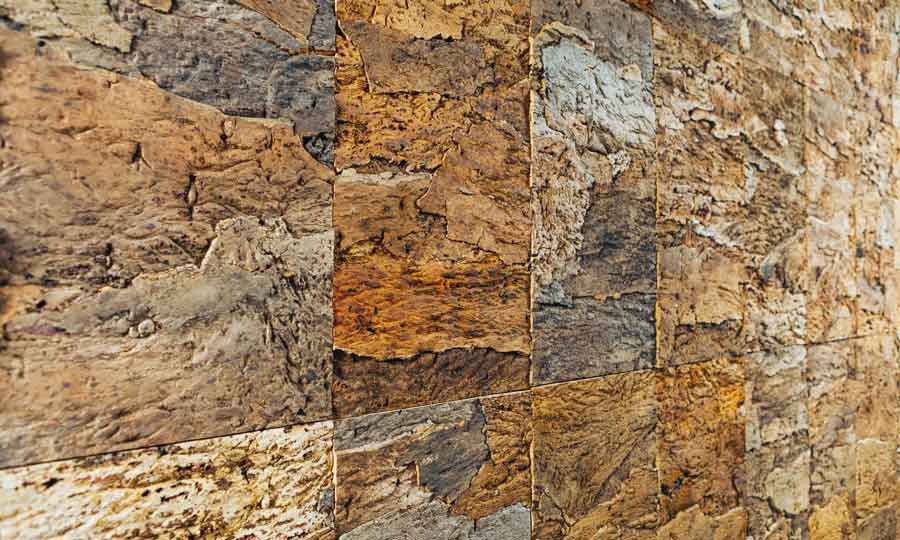
They are often used in residential and commercial spaces, such as offices or studios, where noise reduction is desired. Easy to install and maintain, cork panels add a warm, natural touch to any space.
Here’s how they rank:
- Durability: Cork panels are moderately durable but might not withstand heavy wear and tear like exposed concrete block or cement boards. They can be suitable for general garage use, especially if you value eco-friendliness. Score: 6/10
- Moisture resistance: Cork is a naturally moisture-resistant material that can repel water and prevent the growth of mold and mildew. These textured wall panels aren’t as resistant as options like PVC panels or cement board. Still, it performs better than traditional drywall or gypsum board in damp environments. Score: 8/10
- Insulation: Cork panels provide good thermal insulation and noise reduction, making them an energy-efficient and sound-absorbing choice for temperature and noise control in your garage. Score: 9/10
- Looks: Cork panels have a unique, natural appearance that can add warmth and character to your garage. Score: 7/10
- Ease of installation: Installing cork panels is relatively easy for DIY enthusiasts, as they are lightweight and can be cut to size. You’ll need to take care when securing them to wall studs and may need to apply adhesive or use mechanical fasteners. Score: 8/10
- Budget: Cork panels can be more expensive than some other garage wall coverings because of how they’re constructed. However, the higher cost may be justifiable if you value energy efficiency and sustainability. Score: 6/10
Overall Score: 7.3/10
Cork panels score a 7.3/10 as garage wall coverings, but are much better as a basement wall finishing system. They provide good insulation, moisture resistance, and a unique, eco-friendly aesthetic.
Although they can be pricier than some alternatives, these benefits appeal to homeowners who prioritize sustainability and energy efficiency in their garage spaces.
Plywood, OSB, or MDF
Plywood, OSB, and MDF are different wood materials used for wall coverings, each with advantages and disadvantages. I’ve lumped them together because they all have similar looks, costs, and installations.
Plywood is made by gluing thin layers of wood together, resulting in a strong and stable drywall alternative that doesn’t bend easily and holds nails and screws well.
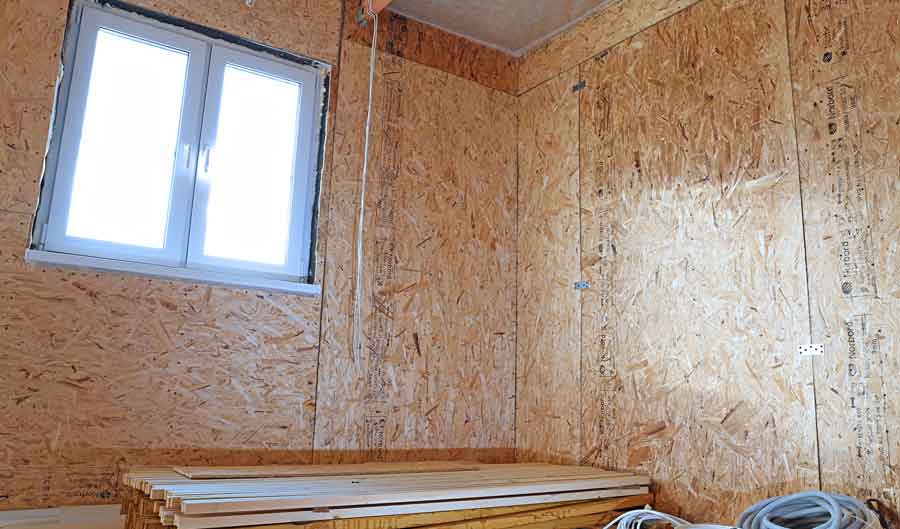
OSB, or Oriented Strand Board, is made from small wood pieces glued together to form a panel. It’s usually more affordable than plywood and works well for walls, but it’s less effective in handling moisture. You might need extra precautions to protect it from humidity in damp areas.
Medium Density Fiberboard (MDF) is made from wood fibers glued into smooth sheets, offering a smooth, paintable surface perfect for walls. However, MDF doesn’t handle moisture well, making it unsuitable for damp areas.
Here’s how they rank:
- Durability: All three options are pretty durable, with plywood being the strongest. OSB and MDF aren’t quite as tough, but they’re still decent for a garage environment. Score: 8/10
- Moisture resistance: When it comes to moisture resistance, these aren’t the best drywall alternatives for your garage. Plywood fares better than MDF and OSB but can still warp or swell if exposed to water for prolonged periods. Score: 5/10
- Insulation: None of these materials are good insulators. Expect to add extra insulation behind them if needed. Score: 6/10
- Looks: Plywood, MDF, and OSB can look good when painted or sealed, but they may not have the same appeal as other options. Plywood has a natural wood grain, which can be a plus if you’re going for a rustic look. MDF and OSB have a smoother, more uniform appearance. Score: 6/10
- Ease of installation: These materials are relatively easy to work with, making them great for DIY projects. You can cut them to size, attach them to studs, and customize them as needed. Score: 9/10
- Budget: Plywood, MDF, and OSB are generally cost-effective options for garage walls, making them attractive for budget-conscious renovators. Score: 9/10
Overall Score: 7.2/10
Considering their durability, ease of installation, and budget-friendliness, plywood, MDF, and OSB score a respectable 7.2/10 as garage wall coverings.
They are not the best choice for moisture resistance or looks. However, OSB and plywood are still solid drywall alternatives for many garage makeovers.
Pegboard or Slatwall
Slatwall and pegboard are two simple ways to cover your garage wall and help you stay organized. Both systems make storing and finding your tools and other items easy.
Garage slatwall systems are made of panels with long slots that hold different hooks, shelves, and holders. The panels can be made from wood, plastic, or metal and come in various sizes and colors. Because the hooks and accessories slide in and out of the rails, it makes it easy to change the layout anytime you want.
Pegboard has come a long way since your dad’s ugly old pegboard. At its core, it’s a wood, metal, or plastic board with many small holes where you can hang hooks or other accessories, which can be easily moved around to fit your needs.
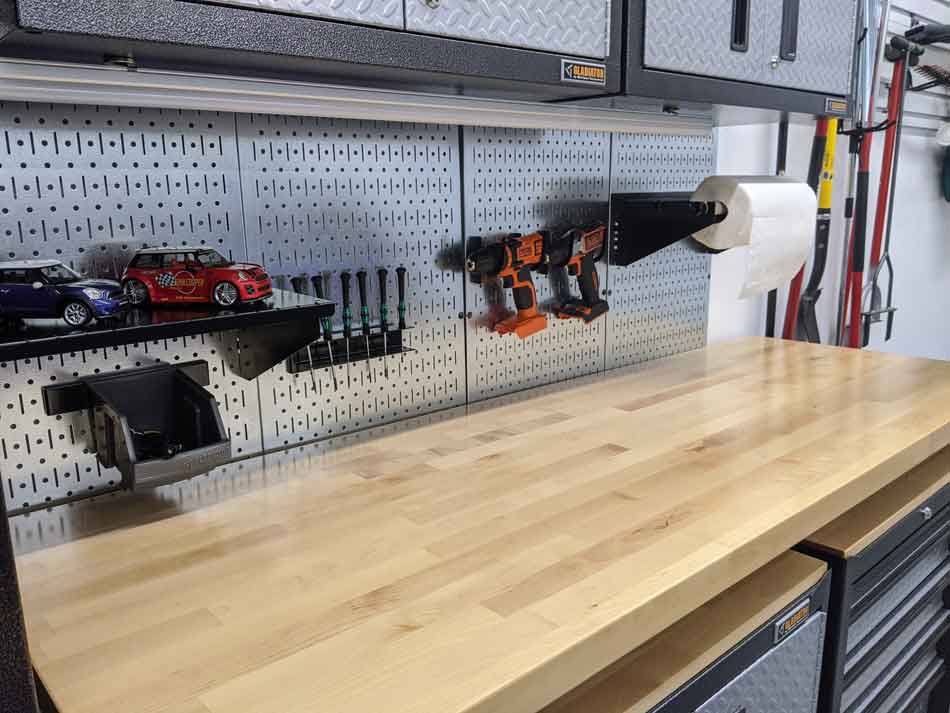
Both slatwall and pegboard help keep your garage neat and organized, and they let you customize your storage space.
Here’s how they rank:
- Durability: Both pegboard and slatwall are relatively durable and can handle the weight of hanging tools and accessories. However, they’re not as tough as drywall alternatives like metal or cement board, so be mindful of their weight limits. Score: 7/10
- Moisture resistance: Neither pegboard nor slatwall is moisture-resistant, especially if made from MDF or particleboard. However, you can find more expensive versions made from PVC or metal, which fare better against moisture. Score: 6/10
- Insulation: These wall coverings don’t offer anything in the way of insulation. You may need to add extra insulation behind them if temperature control is a concern in your garage. Score: 5/10
- Looks: Both pegboard and slatwall provide a clean, organized look that is perfect for a functional garage. Slatwall has a more seamless appearance, while pegboard offers a classic workshop vibe. Score: 8/10
- Ease of installation: Pegboard and slatwall are relatively easy to install, making them great for DIY projects. They can be cut to size and easily attached to wall studs. Score: 9/10
- Budget: While both options are generally affordable, pegboard tends to be more budget-friendly than slatwall. Remember that additional hooks and accessories can quickly increase the price substantially. Score: 8/10
Overall Score: 7.2/10
Pegboard and slatwall score a respectable 7.2/10 as an alternative to drywall or gypsum panels in your garage.
They’re not the most durable or moisture-resistant options, but their ease of installation and functionality make them popular for organizing garages.
Hemp Wall Panels
Hemp wall panels are an eco-friendly and sustainable drywall alternative for your garage walls.
These panels are made from hemp plant fibers mixed with a binder (such as lime) to create a strong and durable material. They provide good insulation, are resistant to mold and pests, and can help regulate humidity in your garage.

The installation process is similar to drywall. Once installed, these panels can be left with a natural finish or painted to match your garage decor.
Here’s how they rank:
- Durability: Hemp wall panels are relatively durable but not as good as concrete block or cement board options. They’re still suitable for general garage use, especially if you want an eco-friendly alternative. Score: 6/10
- Moisture resistance: Hemp wall panels have good moisture resistance and help regulate humidity levels. While they’re less resistant than PVC panels or cement boards, they perform better than traditional drywall in damp environments. Score: 8/10
- Insulation: Hemp wall panels provide good thermal insulation, making them an energy-efficient choice for temperature control in your garage. Score: 9/10
- Looks: Hemp wall panels have a unique, natural appearance that can add warmth and character to your garage. They’re not as versatile as other alternatives but have a distinct look. Score: 7/10
- Ease of installation: Installing hemp wall panels can be easy for DIY enthusiasts, especially if you plan to install them over your existing walls. Some homeowners prefer professional installation for a more polished result. Score: 7/10
- Budget: Hemp wall panels can be more expensive than other wall covering options due to their eco-friendly construction. However, the higher cost may be justifiable if you value energy efficiency and sustainability. Score: 6/10
Overall Score: 7.2/10
Hemp wall panels score a 7.2/10 as garage wall coverings. They provide good insulation, moisture resistance, and a unique, eco-friendly aesthetic.
Although they can be pricier than some alternatives, their many benefits make them appealing to homeowners who prioritize sustainability and energy efficiency in their garage spaces.
Brick or Stone
Brick or stone wall coverings in your garage offer a durable, attractive, and low-maintenance solution for your garage walls. They provide excellent insulation, are fire-resistant, and can withstand a lot of abuse.
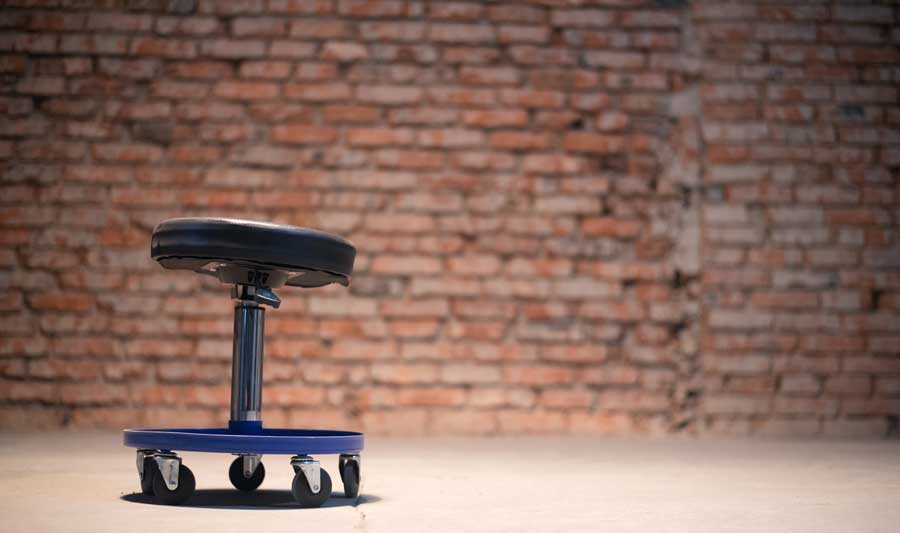
Using brick or stone as a wall covering in your garage typically means constructing a new wall or applying a veneer to your existing wall. Building a new wall requires laying bricks or stones with mortar, while veneer installation involves attaching thin layers of brick or stone to the existing wall using an adhesive.
Here’s how they rank:
- Durability: Brick and stone are incredibly durable drywall alternatives that can handle heavy wear and tear. That makes them them an excellent choice for garages with heavy tools or machinery. Score: 10/10
- Moisture resistance: Brick and stone are naturally moisture-resistant and can withstand damp conditions without rotting or developing mold. However, they may require sealing to prevent water absorption and efflorescence. Score: 8/10
- Insulation: Brick and stone don’t provide insulation on their own. You’ll need to add insulation materials if temperature control is a priority in your garage. Score: 5/10
- Looks: Brick and stone offer a classic, timeless look that can add character and value to your garage. They may not suit everyone’s taste, but they will definitely create an impression. Score: 9/10
- Ease of installation: Installing brick or stone walls is labor-intensive and requires specialized skills, pushing it beyond the realm of most DIY enthusiasts. That’s why most homeowners limit brick or stone to an accent wall. It’s best to hire professionals for this type of project. Score: 3/10
- Budget: Brick and stone can be more expensive than other wall covering options, especially when considering professional installation costs. However, their durability and low maintenance requirements may offset the higher upfront cost in the long run. Score: 6/10
Overall Score: 6.8/10
Brick or stone scores a 6.8/10 as a garage wall covering. They excel in durability and aesthetics but fall short in insulation and ease of installation.
While they have a classic, timeless appearance, they can be costly and require professional installation. If you’re willing to invest in professional installation and prioritize durability and visual appeal, brick or stone could be an excellent drywall alternative for your garage walls.
Synthetic Gypsum Drywall
Synthetic gypsum drywall is made from a byproduct of coal-fired power plants called flue-gas desulfurization (FGD) gypsum. This is then processed and transformed into a material similar to natural gypsum. It’s an eco-friendly method to reduce waste and uses otherwise discarded materials.
It performs similarly to regular drywall, making it a suitable alternative for garage walls. It also offers the same fire resistance and sound insulation properties as traditional drywall.
Here’s how it ranks:
- Durability: Synthetic gypsum drywall has similar durability to traditional drywall. It’s not as durable as cement board or metal panels, but it’s suitable for general garage use. Score: 6/10
- Moisture resistance: Synthetic gypsum drywall typically has improved moisture resistance compared to standard drywall. It’s a better choice for damp environments, but other, more moisture-resistant alternatives are on this list. Score: 7/10
- Insulation: Drywall provides minimal insulation. You’ll need to add extra insulation behind it for optimal temperature control in your garage. Score: 5/10
- Looks: Synthetic gypsum drywall has a smooth, uniform appearance that can be painted or finished to match your desired style. It’s a versatile option that can work with various garage decors. Score: 8/10
- Ease of installation: Installing synthetic gypsum drywall is similar in difficulty to standard drywall. It’s a manageable task for DIY enthusiasts but can be time-consuming and require proper tools and techniques. Score: 7/10
- Budget: Synthetic gypsum drywall is generally affordable but may be slightly more expensive than traditional drywall. Its cost-effectiveness and improved moisture resistance make it an attractive option for budget-conscious renovators. Score: 8/10
Overall Score: 6.8/10
Synthetic gypsum drywall scores a 6.8/10 as a garage wall covering. While it’s not the most durable or moisture-resistant option, its versatility, cost-effectiveness, and aesthetic appeal make it a popular choice for many garage makeovers.
If you’re looking for a more environmentally friendly alternative to traditional drywall with some added benefits, synthetic gypsum drywall could be a great fit for your garage walls.
Concrete \ Cinder Block
Concrete or cinder block walls are a sturdy and durable alternative to ordinary drywall for your garage. They’re known for their strength, resistance to fire and moisture, and excellent insulation properties.
Like brick or stone, constructing a concrete or cinder block wall involves stacking blocks and using mortar to bond them.

This creates a strong and stable structure, ideal for supporting heavy loads or resisting impacts. As you can imagine, this alternative is more labor-intensive and costly than drywall installation.
Here’s how it ranks:
- Durability: Concrete block is an incredibly durable material that can handle heavy wear and tear, making it an excellent choice for garages with heavy tools or machinery. Score: 10/10
- Moisture resistance: Concrete block is naturally moisture-resistant and can withstand damp conditions without rotting or developing mold. However, it can be prone to efflorescence, which occurs when salts leach out of the concrete and create a white, powdery substance on the surface. Score: 8/10
- Insulation: Concrete block doesn’t provide very good insulation on its own. You’ll need to add insulation if temperature control is a priority in your garage. Score: 5/10
- Looks: Concrete block has an industrial look that may not suit everyone’s taste. However, it can be painted, stuccoed, or finished to create a more appealing appearance, making it a versatile option for different styles. Score: 7/10
- Ease of installation: Installing concrete block walls is labor-intensive and requires specialized skills, making it more challenging for DIY enthusiasts. You’ll probably need to hire professionals for this wall covering. Score: 3/10
- Budget: Concrete block can be more expensive than other wall covering options, especially considering professional installation costs. However, it’s durability and low maintenance requirements may offset the higher upfront cost in the long run. Score: 6/10
Overall Score: 6.5/10
Concrete block scores a 6.5/10 as a garage wall covering. It’s great for durability and moisture resistance but is not the best insulator and can be challenging to install.
If you’re willing to invest in professional installation and need something extremely durable, concrete block could be an excellent alternative to drywall for your garage walls.
Barn Boards
Barn boards or reclaimed wood planks are a rustic, environmentally-friendly alternative to ordinary drywall in your garage. The wood comes from old barns or other buildings, repurposed to create a unique and attractive wall covering.
Using barn boards or reclaimed wood for your garage walls adds character. It promotes sustainability by reducing waste and the need for new raw materials.
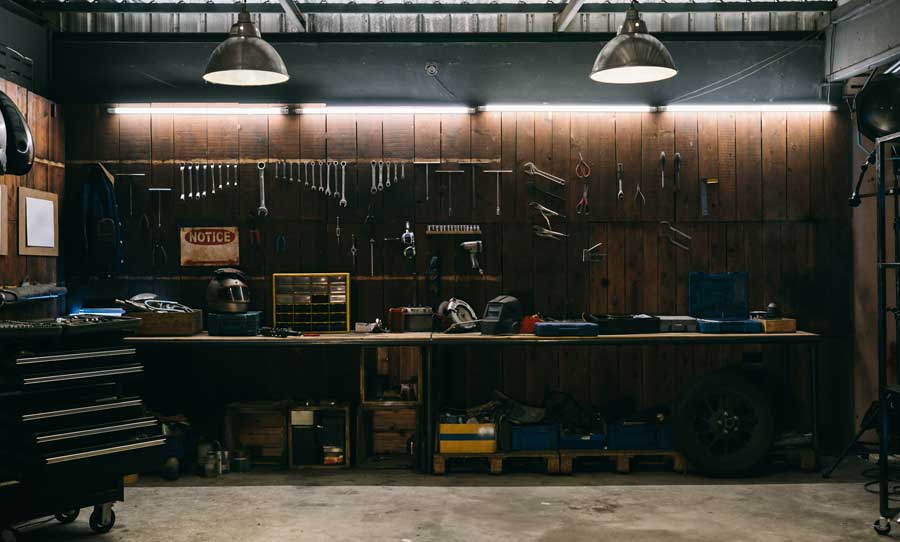
Installation typically involves attaching the boards directly to the wall studs, creating a visually appealing and sturdy surface. Remember that the availability and condition of reclaimed wood can vary, potentially impacting the final look and cost.
Here’s how they rank:
- Durability: Barn boards are durable, especially if made from hardwood or reclaimed from older structures. However, they may not be as robust as alternatives like PVC or cement board. Score: 7/10
- Moisture resistance: Barn boards are not very moisture-resistant and can warp, rot, or develop mold over time. To improve their moisture resistance, you’ll need to treat them with sealants or finishes. Score: 5/10
- Insulation: Barn boards offer no insulation on their own. You’ll need to add extra insulation behind them for optimal temperature control in your garage. Score: 5/10
- Looks: Barn boards have a unique, rustic appearance that can add charm and character to your garage space. They can create a cozy, warm atmosphere that stands out from more industrial-looking alternatives. Score: 9/10
- Ease of installation: Installing barn boards can be moderately easy for DIY enthusiasts. However, the process can be time-consuming, as you’ll need to cut the boards to fit individually. Depending on where you live, sourcing reclaimed barn boards might require effort. Score: 7/10
- Budget: Barn boards are typically more expensive than other wall covering options, especially if you purchase reclaimed or hardwood boards. However, their unique look may justify the higher cost for some homeowners. Score: 6/10
Overall Score: 6.5/10
Barn boards score a 6.5/10 as a garage wall covering. They offer a unique, rustic aesthetic and decent durability but fall short in moisture resistance and insulation.
If you’re willing to put in the effort to source, treat, and install barn boards and love their cozy charm, they could be a great-looking alternative to drywall for your garage walls.
Acoustic Panels
Acoustic panels are made from foam, fabric, or perforated wood. They’re designed to improve sound quality and reduce noise levels by absorbing or diffusing sound waves to minimize echoes and reverberations.
Acoustic panels are a must-have in your garage if you plan to use it for activities such as band practice, video production, or woodworking.
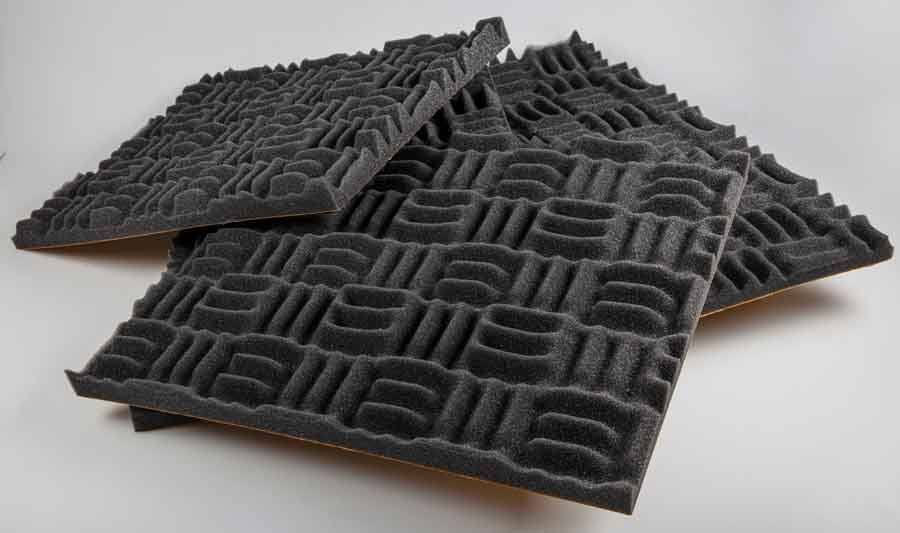
Installation typically involves attaching the panels to the existing wall structure directly or using a mounting system.
Remember that while these panels are effective for sound management, they may not offer the same structural or insulation properties as traditional drywall.
Here’s how they rank:
- Durability: Acoustic panels vary in durability, depending on the materials used. They’re generally suitable for garages but may not be the best option if you expect heavy wear and tear. Score: 6/10
- Moisture resistance: Moisture resistance varies among acoustic panels, depending on the materials and construction. Some can handle damp environments, while others may be less resistant. Choosing panels specifically designed for moisture resistance is essential if that’s a concern. Score: 6/10
- Insulation: Acoustic panels are designed primarily for sound absorption and noise reduction. While they may provide some thermal insulation, that’s not their primary purpose. Score: 6/10
- Looks: Acoustic panels come in various styles and finishes, offering a range of aesthetic options. While they can be made to look good, they’re not the best option if you want a more traditional or industrial garage look. Score: 7/10
- Ease of installation: Acoustic panels are generally easy to install for DIY enthusiasts. Depending on the panel type, they can be mounted with adhesive, clips, or other fastening methods. Score: 8/10
- Budget: Acoustic panels can be more expensive than other wall coverings, especially if you choose high-quality materials or custom designs. They may not be the most cost-effective choice if your garage doesn’t require sound absorption. Score: 5/10
Overall Score: 6.3/10
Acoustic panels score a 6.3/10 as garage wall coverings. They excel in noise reduction but may not be the best choice for other factors like insulation and moisture resistance.
If sound absorption is a priority and you’re willing to invest in higher-quality materials, acoustic panels could be a suitable option for your garage walls. However, other drywall alternatives might be more appropriate for a more well-rounded solution in your garage.
